Looking for a really accurate, flat shooting, and hard hitting cartridge? Here’s what you need to know about the 300 Win Mag vs 338 Lapua vs 338 Win Mag.
I think most hunters would agree that the .300 Winchester Magnum, .338 Winchester Magnum, and .338 Lapua Magnum rounds are serious heavy hitters that can get the job done on big game. They are all relatively flat shooting and accurate cartridges that carry a lot of energy out to longer ranges.
However, the designers of each cartridge were trying to accomplish very different goals and built each one prioritizing specific attributes. For this reason, there are some massive differences between those three cartridges and they have very different strengths and weaknesses. Not surprisingly, though there is a little bit of overlap in their best uses, the .300 Win Mag, .338 Win Mag, and .338 Lapua are all best suited for distinct tasks.
In this article, I discuss the pros and cons of the 300 Win Mag vs 338 Lapua vs 338 Win Mag so you can make an informed decision regarding which cartridge fits your particular needs the best.
Table of Contents
I also recorded an entire podcast episode on this exact subject. If you’d rather listen than read, click the appropriate link below to listen to this episode on your preferred podcasting service.
300 Win Mag vs 338 Lapua vs 338 Win Mag Podcast
Apple | Google | iHeart | Pandora | Spotify
338 Win Mag vs 300 Win Mag vs 338 Lapua: History
First, I recorded an entire video episode on this exact subject. If you’d rather listen or watch than read, watch the YouTube video below.
The years following World War II were a true renaissance of civilian firearm and cartridge development in the United States. That time period saw a flood of new centerfire rifle cartridges like the .222 Remington, the .280 Remington, and the .308 Winchester (and it’s descendants the .243 Winchester and the 7mm-08 Remington).
Around that same time, the “Magnum Era” also began in earnest when Winchester rolled out a line of new belted magnum cartridges utilizing a modified .375 H&H case. The .458 Winchester Magnum came first in 1956 and was followed by the .338 Winchester Magnum and the .264 Winchester Magnum during the next couple of years.
Those cartridges utilized a .375 H&H Magnum case necked down (or up, in the case of the .458 Win Mag) and shortened from 2.85″ to 2.5″ long. The designers opted for those shortened cases so that all three cartridges would fit in a standard length rifle action (same as the .30-06 Springfield) instead of the longer magnum length action required by the original .375 H&H cartridge.
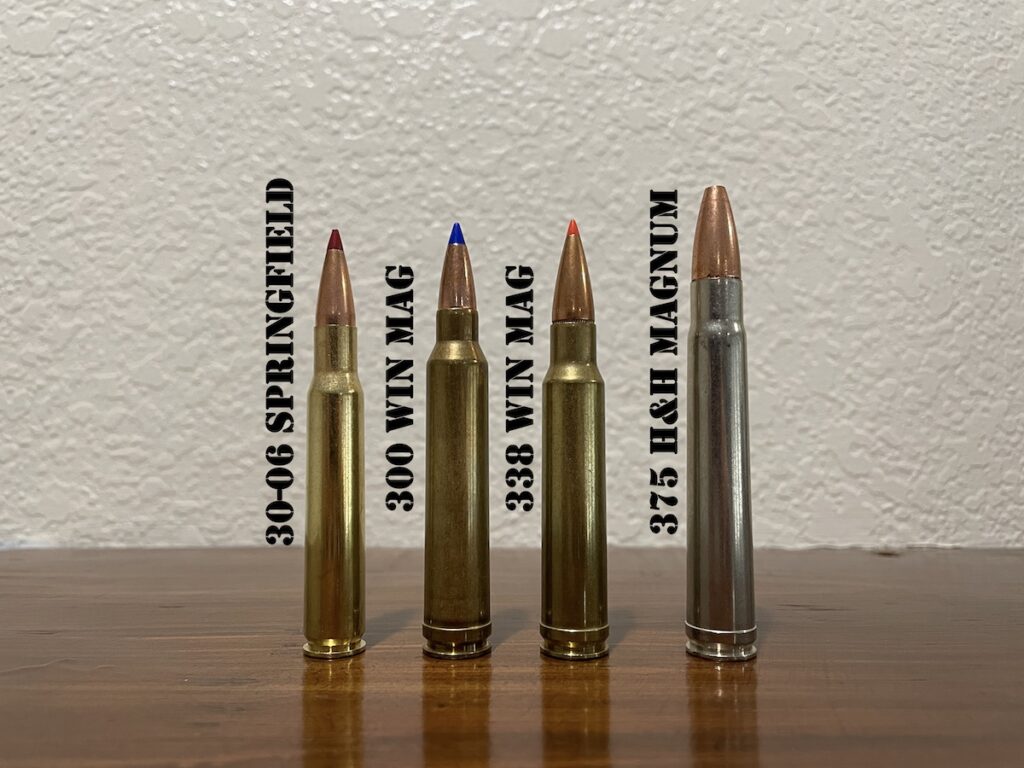
Winchester offered the cartridges in their legendary Model 70 rifle and marketed each one to a particular segment of the American hunting community: the .264 Win Mag to western hunters wanting a flatter shooting cartridge for thin-skinned game like mule deer or pronghorn, the .338 Win Mag to hunters pursuing really large and/or tough North American game like moose and grizzly bear, and the .458 Win Mag to hunters going afield after dangerous game like cape buffalo in Africa.
The .338 Winchester Magnum wasn’t an immediate commercial success for the company, but it has gradually developed a reputation as an excellent all-around cartridge for big game during the ensuring decades. It’s not an extremely widely used or popular cartridge, but the .338 Win Mag is very well-liked in that portion of the hunting community desiring a powerful and reliable medium bore rifle, like brown/grizzly bear guides up in Alaska.
Indeed, able to push a 225 grain bullet at 2,800 feet per second (3,918 ft-lbs of muzzle energy) the medium bore .338 Winchester is quite powerful and is capable of ethically taking almost any species of game in the world.
Winchester didn’t stop with the .264, .338, and .458 Win Mag cartridges though. Remington sent shockwaves through the hunting and shooting worlds when they introduced the 7mm Remington Magnum in 1962, which also used a shortened and necked down .375 H&H case. Winchester picked up the gauntlet Remington had thrown down and responded the following year with the .300 Winchester Magnum (also known as the .300 Win Mag or .300 WM).
Built using a modified .338 Winchester Magnum case, the .300 Winchester Magnum basically duplicated the performance of the other fast .30 caliber cartridges of the day like the .300 H&H Magnum and .308 Norma. Like the other new Winchester belted magnums as well as the 7mm Remington Magnum, the .300 Win Mag also utilized a shorter case that fit in a standard length rifle action.
Typical 300 Win Mag loads can push a 180-grain bullet at 2,960fps (3,500ft-lbs) or a 150 grain bullet at 3,300fps (3,626ft-lbs).
Offering a dramatic improvement in performance over the venerable .30-06 Springfield that also compared favorably to the 7mm Rem Mag in many areas, the .300 Win Mag was an almost instant commercial success for Winchester and remains one of the most popular big game hunting cartridges in North America to this day.
For an in-depth discussion on the .300 Winchester Magnum and how it stacks up to the .30-06 Springfield, 7mm Remington Magnum, 28 Nosler, and 6.5 Creedmoor cartridges, read the articles below:
308 vs 30-06 vs 300 Win Mag: Which Cartridge Should You Be Hunting With?
7mm Rem Mag vs 300 Win Mag: What You Know May Be Wrong
28 Nosler vs 300 Win Mag: Reivew & Comparison
6.5 Creedmoor vs 300 Win Mag: What You Need To Know
While the .300 Win Mag and the .338 Win Mag were both developed for big game hunting, the .338 Lapua was originally designed as a long range sniper round for military use. Specifically, the designers of the .338 Lapua were trying to build a very accurate and flat shooting round that was more powerful and had a longer effective range than the 7.62x51mm NATO, but did not require as large or heavy of a rifle as the .50 BMG.
Formally introduced by Lapua Limited in 1987, the designers of the .338 Lapua Magnum accomplished those goals by utilizing a new case based on the .416 Rigby.

Typical 338 Lapua Magnum ballistics are a 250gr bullet at just over 3,000fps (about 5,095ft-lbs) or a 300gr bullet at nearly 2,800fps (about 5,150ft-bs).
The .338 Lapua is now very highly regarded as a long range cartridge and has seen extensive use in the hands of military snipers from numerous countries. In addition to having a really long effective range and having lots of stopping power, the cartridge is also (allegedly) capable of penetrating military body armor at ranges in excess of 1,000 yards.
Though the record has since been broken, British Army sniper Corporal of Horse Craig Harrison held the record for the longest sniper kill for many years while using an Accuracy International L115A3 sniper rifle chambered in .338 Lapua Magnum. He used that rifle and cartridge to kill two Taliban machine-gunners 2,707 yards (2,475 meters) away in Afghanistan’s Helmand Province during 2009. American sniper Chris Kyle also used the .338 Lapua to achieve his longest personal kill of 2,100 yards (1,920 meters) in Iraq back in 2008 (American Sniper, p398-399).
The .338 Lapua has also gradually crossed over into the hunting community in recent years. Though few hunters have a need to utilize the extreme long range capabilities of the cartridge, the .338 Lapua is still capable of delivering more power at longer range than just about any other comparable round. As we’ll discuss in detail shortly, the Lapua also utilizes very aerodynamic bullets that retain energy and resist wind drift exceptionally well.
300 Win Mag vs 338 Lapua vs 338 Win Mag: Cartridge Sizes
The shared heritage of the .300 Win Mag and .338 Win Mag, as well as the unique roots of the .338 Lapua, is obvious in the photo below.
While .300 Wing Mag uses a slightly longer case with a shoulder that sits .156″ further forward than on the .338 Win Mag case, both cartridges have the same 25 degree shoulder angle and the same overall length of 3.34″. Both cartridges are also belted magnums with the same .532″ rim diameter and the same SAAMI maximum average pressure of 64,000psi.
Due to its longer case length and the difference in placement of the shoulder, the .300 Win Mag does have a slightly greater case capacity than the .338 Win Mag
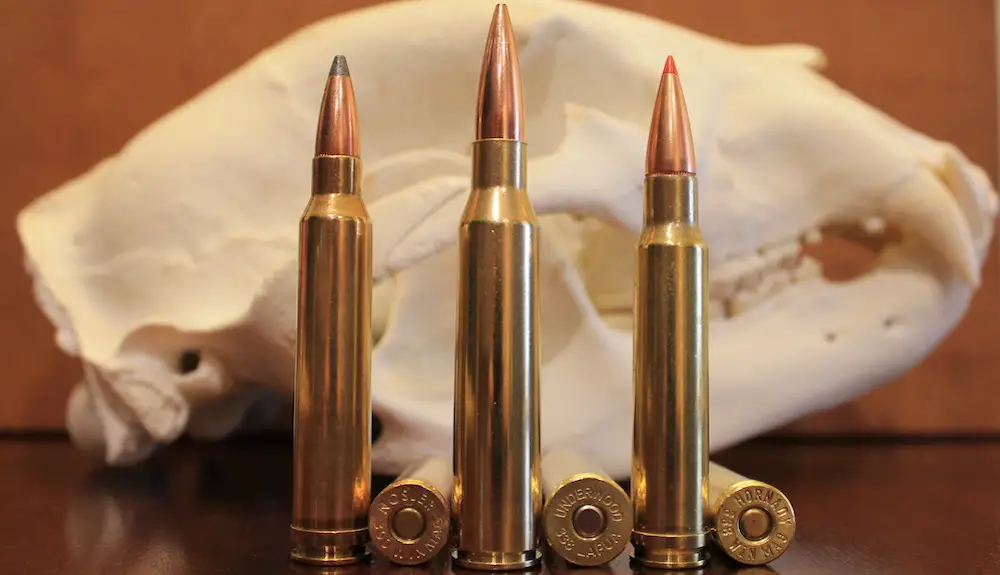
On the other hand, the .338 Lapua is significantly longer than both Winchester Magnum rounds and is also not a belted magnum cartridge like the other two. The Lapua cartridge also uses a larger, .588″ rim diameter. Not surprisingly, it has significantly more case capacity than both the .300 and .338 Win Mag. It also has a higher maximum SAAMI pressure of 65,000psi.
However, while the .300 and .338 Win Mag will both fit in a standard/long action rifle, the .338 Lapua Magnum requires a much longer rifle action.
Finally, the .300 Win Mag utilizes .308″ bullets while the .338 Win Mag and .338 Lapua both shoot larger .338″ bullets.

338 Win Mag vs 300 Win Mag vs 338 Lapua Ballistics
Not surprisingly, there are some significant differences in the ballistics of the three cartridges.
The ballistics chart below compares the trajectory of Hornady Precision Hunter and Winchester Expedition Big Game and factory loads for each cartridge.
Specifically, the table compares 200gr ELD-X (.597 BC) and 180gr AccuBond (.509 BC) bullets in .300 Win Mag, to 230gr ELD-X (.616 BC) and 225gr AccuBond (.548 BC) bullets in .338 Win Mag, to 270gr ELD-X (.757 BC) and 300gr AccuBond (.720 BC) bullets in .338 Lapua.
All six loads used a 200 yard zero.
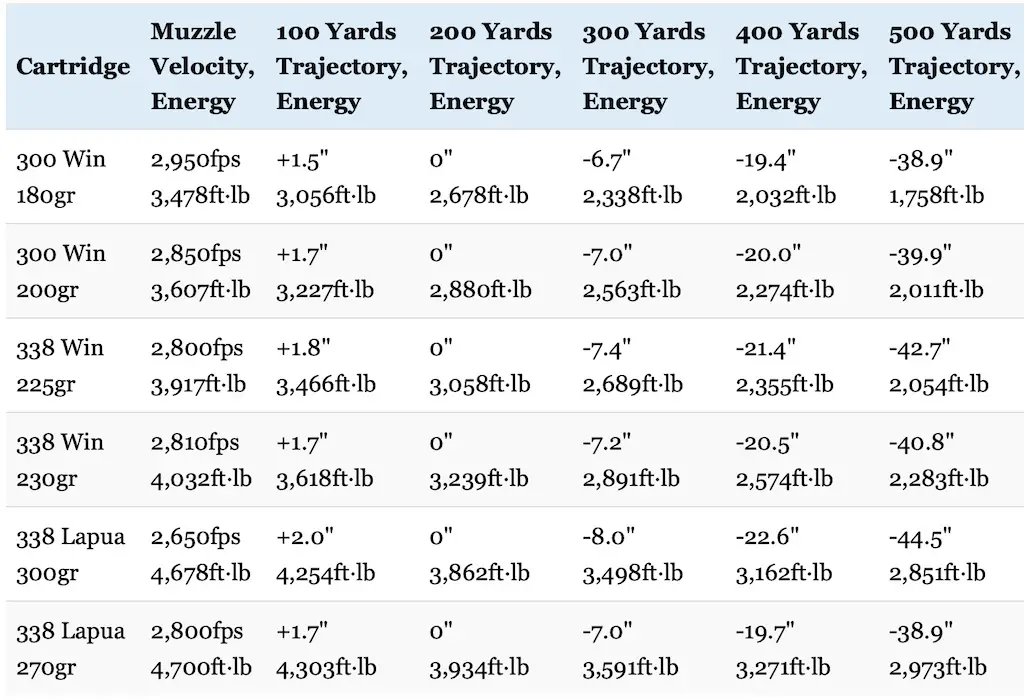
Interestingly enough, there’s not a tremendous difference in the trajectory of the three cartridges out to 500 yards: just 5.6″ between the flattest and the most arching trajectory. That works out to about a 15% difference, which certainly isn’t anything to turn up your nose at. But in general, they’re all relatively flat shooting cartridges (though not quite to the extent of some of the popular high velocity varmint cartridges)
However, what really sets these cartridges apart is how well they retain energy at longer range. This is particularly true with the .338 Winchester and the .338 Lapua. Indeed, as powerful as the .300 Win Mag is, the .338 Lapua ELD-X load has almost as much kinetic energy at 500 yards as the .300 Win Mag AccuBond load has at 100 yards!
Since this article is focused on the hunting applications of the three cartridges, I did not include any data past 500 yards, but all of them (the .338 Lapua in particular) continue to perform well at even longer range.
The chart below compares how much a 10 mile per hour crosswind impacts those same .300 Win Mag, .338 Win Mag, and .338 Lapua Mag loads out to 500 yards.
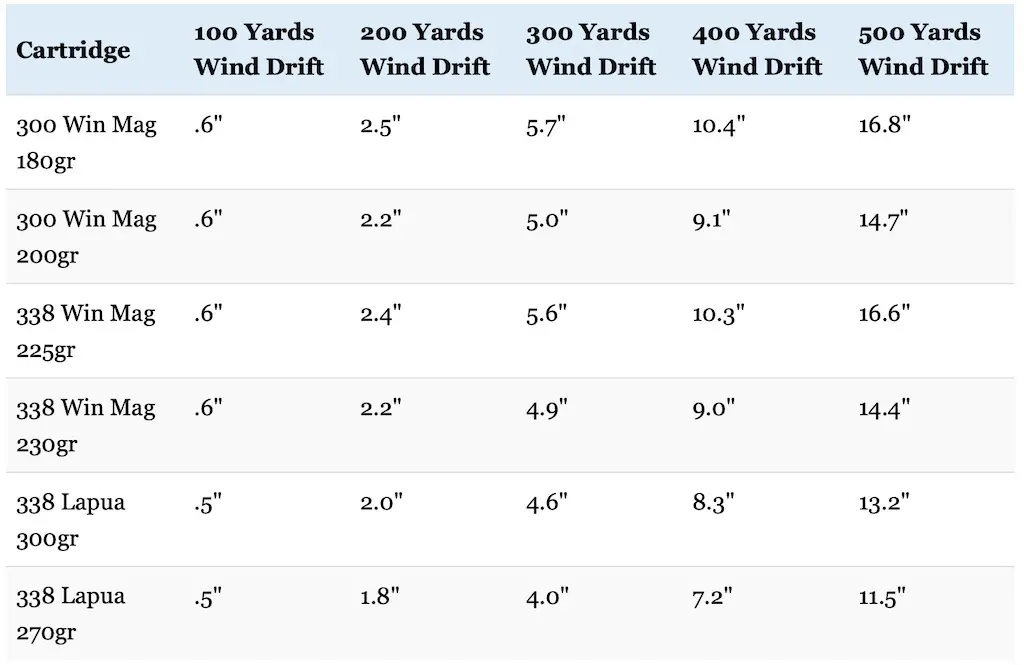
Once again, all three cartridges perform very well, but the .338 Lapua has the edge here. Not surprisingly, those heavy, high ballistic coefficient bullets shot at a high muzzle velocity are especially resistant to wind drift and very few other rifle cartridges can provide a comparable level of performance.
That performance comes at a price though: recoil.
The table below compares the recoil produced by those cartridges when fired from a Weatherby Mark V AccuMark rifle that weighs either 8.25 pounds (.300 Win Mag) or 8.5 pounds (.338 Win Mag and Lapua).
Felt recoil will vary from shooter to shooter and rifle to rifle, but free recoil energy is still a useful way to compare cartridges.
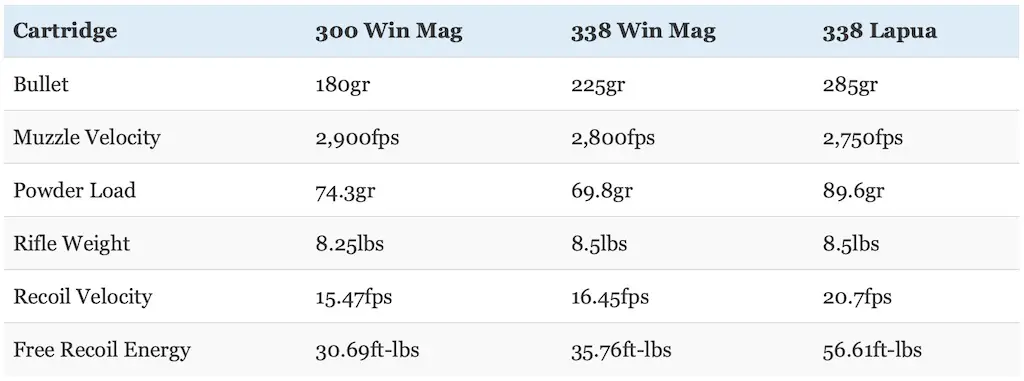
As you can see, the .338 Win Mag has a little bit (~16% more) more free recoil energy than the .300 Win Mag. However, the .338 Lapua clearly has the fiercest recoil of the bunch: an astounding 85% more free recoil energy than the .300 Win Mag, even when used in a slightly heavier rifle! That’s really saying something when you consider that the .300 Win Mag is hardly known as a mild recoiling cartridge itself.
Now, this particular Weatherby rifle (which is indeed currently manufactured and sold by Weatherby) is a pretty light hunting rifle for a cartridge like the .338 Lapua and I only used it to provide an apples to apples comparison of the three cartridges. Clearly, that rifle in .338 Lapua would have a very stout recoil.
That’s why most .338 Lapua rifles are pretty heavy and incorporate other recoil reducing features like a muzzle brake. For instance, the Savage 110 FCP in .338 Lapua weighs 10 pounds while the Ruger Precision Rifle and Accuracy International AWM weigh over 15 pounds each.
That exact same .338 Lapua load fired in a 15 pound rifle would produce only 32.08 foot pounds of free recoil energy, which is only a tiny bit more than the .300 Win Mag in the 8.25 pound Weatherby.
There are also some very important differences between the three cartridges when it comes to bullet size.
The .300 Winchester Magnum uses the smallest and lightest bullets of the three: .308 caliber bullets in the 150-230 grain range. 150 grain, 165 grain, 180 grain, 190 grain, 200 grain, and 220 grain bullets are the most popular for the cartridge.
The .338 Lapua and .338 Win Mag both utilize larger .338 caliber bullets. However, the .338 Lapua can generally use heavier bullets than the .338 Win Mag. For example, while it’s uncommon to see .338 Win Mag ammo using bullets heavier than 250 grains (225 and 250 grain bullet weights are most common), 270 grain, 280 grain, 285 grain, and even 300 grain bullets are very popular with the .338 Lapua.
Since they use larger diameter bullets, the .338 Win Mag and .338 Lapua have about 20% more frontal surface area (also known as cross sectional area) than the .300 Win Mag (.0897 vs .0745 square inches). All other things being equal, a bigger bullet will make a bigger hole, cause more tissue damage, and result in more blood loss.
Additionally, the .338 Lapua also has an advantage in bullet sectional density compared to both other cartridges.
Sectional density (SD) is a measure of the ratio of the diameter of a projectile to its mass. All other things equal, a heavier projectile of a given caliber will be longer and therefore have a higher sectional density and consequently penetrate deeper than projectiles with a lower mass and sectional density.
A 270 grain .338″ bullet has a sectional density of .338 and a 300 grain .338″ bullet has a sectional density of .375. This compares favorably to the .313 sectional density of a 250gr .338″ bullet, the .281 sectional density of a 225gr .338″ bullet, the .319 sectional density of a 212gr .308″ bullet, the .301 sectional density of a 200gr .308″ bullet, and the .271 sectional density of a 180gr .308″ bullet.
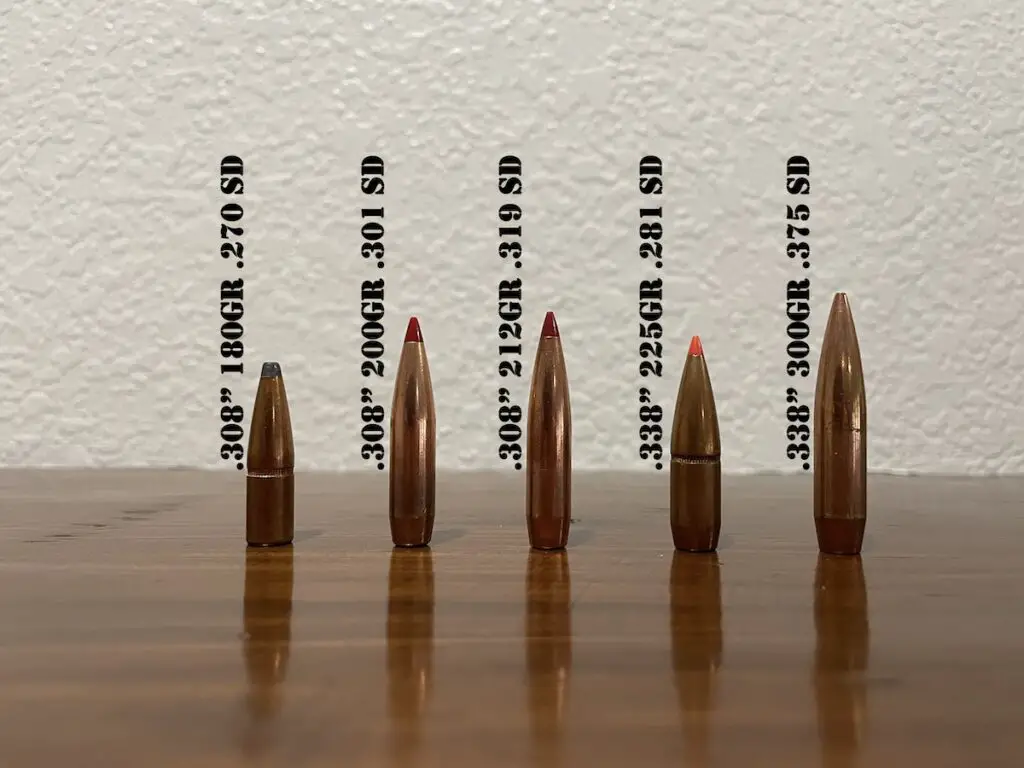
So where do we stand with each cartridge?
They’re all very powerful and flat shooting cartridges, but the .338 Lapua is clearly the most powerful of the bunch and has the most resistance to wind drift. It has the same frontal surface area as the .338 Win Mag and both cartridges have about 20% more frontal surface area than the .300 Win Mag. It also commonly uses high BC bullets with a much higher sectional density than both other cartridges.
However, all that comes at the expense of much more recoil than the .300 Win Mag and the .338 Win Mag. We’ll discuss this more in a minute, but since the cartridge is designed primarily for long range shooting and has such a heavy recoil, the .338 Lapua is most commonly available in very heavy rifles that dampen recoil, but are more difficult to carry.
Depending on the specific load being compared, the .300 Win Mag has either the flattest or the second flattest trajectory (behind the .338 Lapua). While it does have the least kinetic energy at all ranges, it’s still relatively powerful and is suitable for most species of big game. It also shoots smaller and lighter bullets and has less recoil than the other two cartridges.
The .338 Winchester falls more or less in the middle: it has less recoil and retains less kinetic energy than the .338 Lapua, but more recoil and more kinetic energy at all ranges than the .300 Win Mag. Again, depending on the exact load in question, the .338 Win Mag either has the most arching trajectory, or the second most arching trajectory (either ahead or behind the .338 Lapua).
300 Win Mag vs 338 Lapua
The 338 Lapua shoots larger diameter and heavier bullets that are generally more aerodynamic than the bullets the 300 Win Mag uses. The two cartridges have a similar trajectory at normal hunting ranges, but typical 338 Lapua loads have 30-40% more muzzle energy. The 338 Lapua has nearly twice as much recoil energy though.
338 Win Mag vs 338 Lapua
Both cartridges shoot the same diameter bullets, but the 338 Lapua normally uses heavier and more aerodynamic bullets with a higher sectional density than the 338 Win Mag. For this reason, the 338 Lapua has a flatter trajectory, penetrates better, and retains more kinetic energy at typical hunting ranges. The 338 Win Mag has less recoil.
300 Win Mag vs 338 Win Mag
The 338 Win Mag shoots heavier and larger diameter bullets that are generally more aerodynamic than the bullets the 300 Win Mag uses. The 300 Win Mag has less recoil and a slightly flatter trajectory at normal hunting ranges, but typical 338 Win Mag loads have 10-15% more muzzle energy and about 20% more frontal surface area.
300 Win Mag vs 338 Win Mag vs 338 Lapua: Ammunition Selection
The .300 Winchester Magnum is by far the most popular cartridge of the three and it’s consistently among the best selling rifle cartridges in the United States each year. The .338 Winchester and .338 Lapua both really lag behind the .300 Win Mag in popularity, but neither is rare.
Many of the really big ammunition manufacturers like Barnes, Berger, Federal, Hornady, Norma, Nosler, Remington, Swift, and Winchester produce a good quality hunting ammo for all three cartridges.
Prices and availability vary from region to region, but the .300 Win Mag is by far the most common and least expensive. The .338 Win Mag is a little more expensive, but .338 Lapua factory ammo is by far the most expensive of the bunch and can cost twice as much (or more) than .300 Win Mag ammo.
Read the article below if you’d like to learn more details about some of the various hunting ammunition choices for the .300 Win Mag.
Best .300 Winchester Magnum Ammunition For Hunting Elk, Deer, Moose, & Other Big Game
All three cartridges are relatively popular among reloaders and handloading components are widely available. The .308″ bullets used by the .300 Win Mag are also used by other cartridges like the .308 Winchester, .30-06 Springfield, .300 Winchester Short Magnum (300 WSM), .300 Weatherby Magnum, and .300 Ultra Mag.
By the same token, the .338″ bullets used by the .338 Lapua and .338 Win Mag are also used by the .338 Federal, the .338 Ruger Compact Magnum (338 RCM), the .338 Remington Ultra Mag, the .340 Weatherby Magnum, and the .338-378 Weatherby Magnum.
So, there’s a plethora of good quality bullets available to go around.
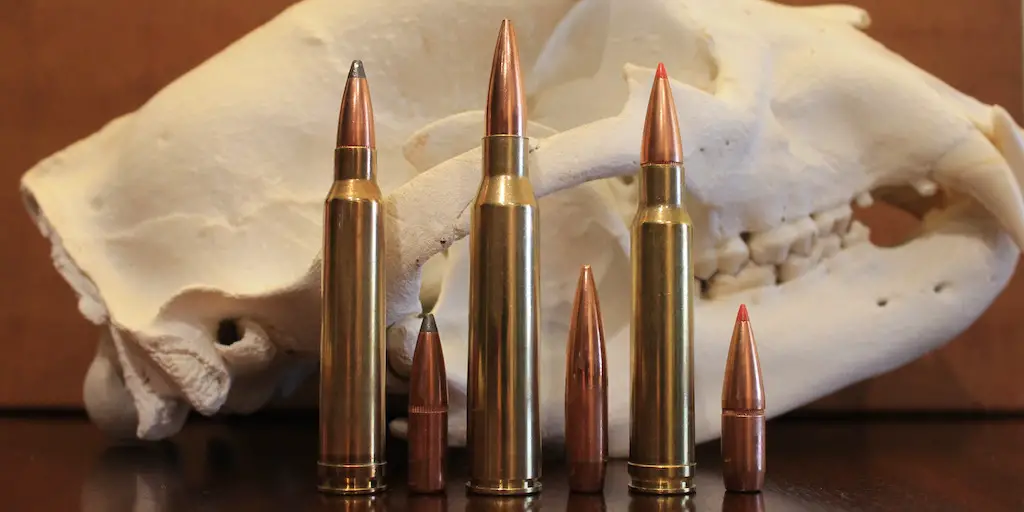
300 Win Mag vs 338 Win Mag vs 338 Lapua: Rifle Selection
When it comes to prices and availability of quality hunting rifles, .338 Lapua Magnum cannot touch the .300 and the .338 Winchester Magnum. That’s not really surprising when you consider the roots of the cartridges though.
Now don’t get me wrong: there are a number of really good .338 Lapua bolt-action rifles out there.
The problem is that most .338 Lapua rifles are specifically designed for military use and/or civilian long range precision shooting and are therefore expensive, very heavy, and have a really long barrel like the Accuracy International AXMC, the Barrett MRAD, or the Sako TRG.
There are exceptions though, like the Savage 110 Long Range Hunter and the aforementioned Weatherby Mark V, which are much lighter and not quite as expensive as the others. However, those rifles also have their own downsides, which I’ll get discuss in more detail in the next section.
On the other hand, since they don’t require a really long barrel or a heavy rifle for best performance, the .300 Win Mag and .338 Win Mag are both manufactured in a number of really good bolt-action hunting rifles. The .300 Win Mag is especially common and virtually every model produced by any firearms manufacturer of note is available in the cartridge.
Even so, the .338 Win Mag is not rare by any stretch of the imagination and rifles like the Browning X-Bolt, the Mossberg Patriot, the Ruger American, Guide Gun, and Hawkeye, the Savage 110, the Tikka T3x, as well as the Winchester XPR and the Model 70 are available in both cartridges. Even the semi-automatic Browning Automatic Rifle is produced in both .300 and .338 Win Mag.
Read the article below if you’d like to learn more details about some of the various hunting rifle choices for the .300 Winchester Magnum.
Best .300 Win Mag Rifles For Hunting – Ultimate Guide
300 Win Mag vs 338 Lapua vs 338 Win Mag: Which Is Right For You?
While all three cartridges appear well suited for hunting many species of big game at first glance, this is where their real world performance really starts to diverge. In particular, even though the .338 Lapua is indeed extremely powerful and (at least on paper anyway) is capable of cleanly taking virtually any species of big game, there are real downsides to using it afield.
Remember: this cartridge was purpose built for long-range shooting.
Well, this is especially apparent when it comes to choosing a rifle in .338 Lapua. The reality of dealing with a such a powerful cartridge that was originally designed for extreme long range performance presents the user with a dilemma: do you want to lug a really big and heavy rifle weighing upwards of 15 pounds with a 26-28″ barrel through the woods or up a mountain? Or would you rather use a lighter, 8-10 pound .338 Lapua rifle that’s easier to carry, but with much more recoil?
Remember when I talked earlier about how the designers of the .338 Lapua wanted a cartridge with good long range performance without requiring as large or heavy of a rifle as the .50 BMG? Well, as heavy as .338 Lapua rifles are, carrying one afield is certainly much easier than carrying a Barrett .50 cal that weighs 25 pounds (or more) and there are plenty hunters who take game with the Lapua each year. It will also really do a number on really big game like elk and moose with good shot placement.
Heck, Brandon Maddox of Silencer Central even used one (in combination with one of his Banish 338 suppressors) to cleanly kill a cape buffalo in 2023 (with a 270gr ELD-X bullet no less!).
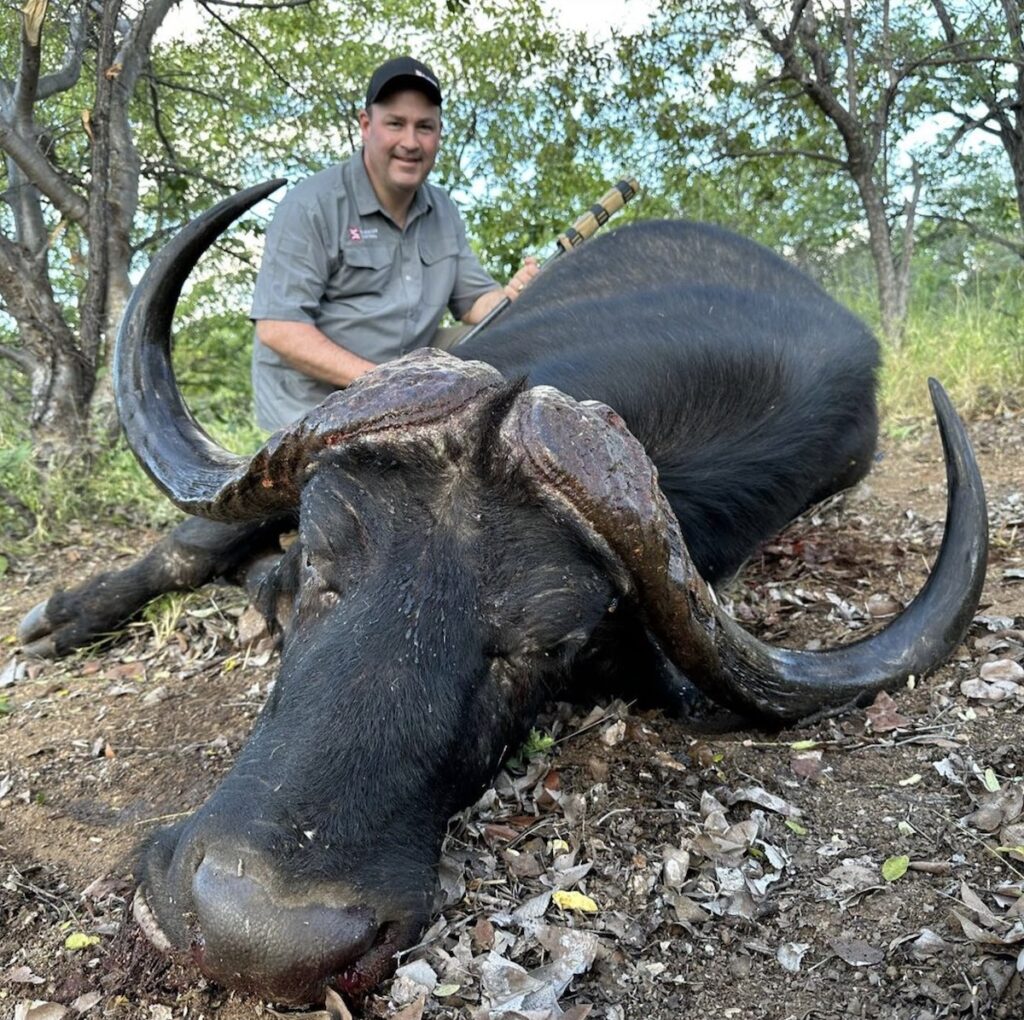
To be clear: I do not recommend using any of these cartridges (or the ELD-X bullet) for hunting cape buffalo. That particular Hornady load uses a heavy bullet going pretty fast (~2,800fps), but the ELD-X is softer than what I’d like for buffalo. Plus, using a .338 caliber cartridge is not legal in some African countries that have a .375 caliber minimum for hunting thick skinned dangerous game like buffalo.
Even so, it clearly worked for Brandon and it’s also a fact that the 338 Lapua Magnum’s nearly 4,700 ft-lbs of muzzle energy exceeds that of noted dangerous game cartridges like the 375 H&H and either equals or approaches the level of other big bore rounds like the 404 Jeffery and 416 Rigby.
Additionally, there are honestly very few hunting situations that require a cartridge as powerful as the .338 Lapua. This reason, combined with the aforementioned shortcomings of the .338 Lapua with regards to rifle weight, recoil, and ammunition cost, are why many hunters instead gravitate toward cartridges like the .300 and .338 Win Mag (or even the .375 H&H) instead that are still plenty powerful, but have more manageable recoil in a lighter and easy to carry rifle.
Do you primarily hunt black bear, deer, or hogs in an area where long distance shots past 200 yards are uncommon and bullet drop isn’t a big concern? All three cartridges will work just fine under these circumstances from a purely ballistics perspective.
However, while there’s nothing necessarily wrong with using any of those cartridges in those sort of situations, if that’s the only sort of hunting you do, then none of them are strictly necessary and you could easily get away with something lighter. Of the three, I’d say to go with the .300 Win Mag since ammo is generally cheaper and it has less recoil than the others.
But on the other hand, there’s nothing wrong with using a 338 Win Mag or even the mighty 338 Lapua Magnum on a deer hunt either.
Adam Wies (better known as WHO_TEE_WHO on YouTube) killed a nice mule deer in Montana with his Savage 110 in 338 Lapua a couple years ago. That buck was about 170 yards and dropped like a ton of bricks after Adam hit him with a single 270gr ELD-X bullet from Hornady Precision Hunter ammo line.
Was that cartridge absolutely necessary for the conditions? Not at all, but it sure sounds like he had a fun hunt though!
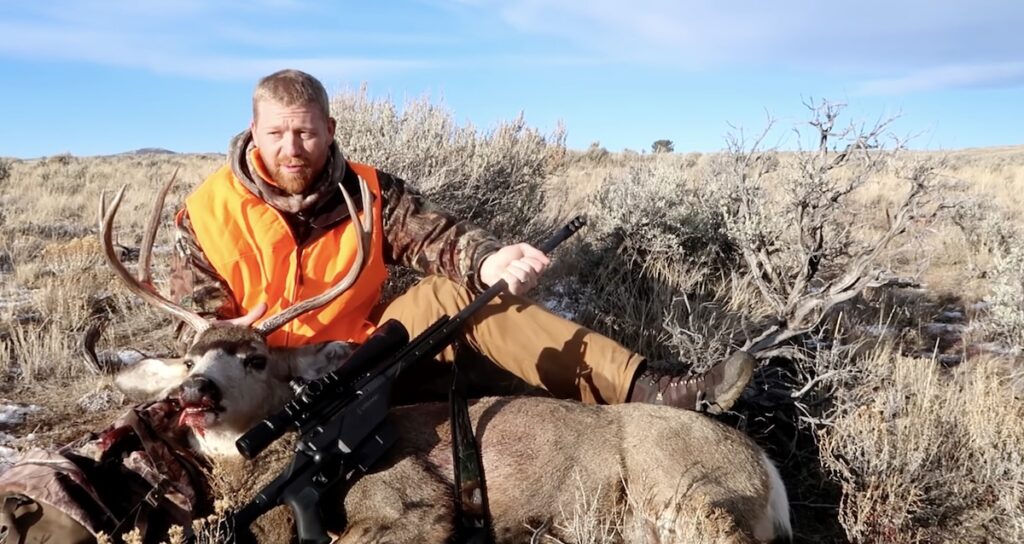
Adam told me the whole set-up weighed about 12 pounds, but wasn’t a big issue for him because they were riding horses for most of the hunt. Keep that downside of the 338 Lapua in mind if you’re considering using one on a hunt in the future!
It will darn sure work, but I can see how that rifle would be a pain to carry after awhile!
Are you more sensitive to recoil? Do you spend a lot of time in the mountains or the backcountry mountain goat, sheep, or tahr hunting where it’s really nice to have a lightweight rifle? None are really known as classic sheep or mountain hunting cartridges, but once again, I’d lean towards the .300 Win Mag since it has a very flat trajectory, lighter recoil, and is available in lighter and easier to carry hunting rifles.
For instance, I took a Himalayan Tahr with my 300 Win Mag on a hunt in New Zealand. That hit staggered the tahr and he ran less than 50 yards after the shot.
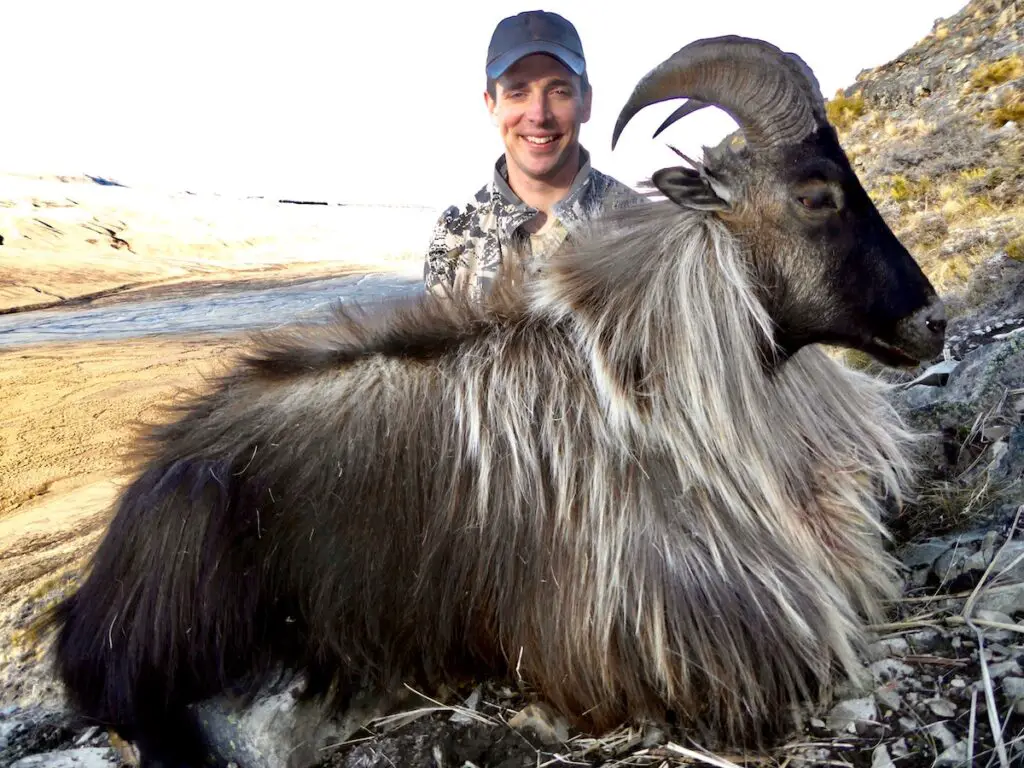
That was a pretty physically demanding hunt and you can see how steep those mountains were in the photo below my guide took of me right after my shot. I’m really glad I wasn’t lugging a much bigger and heavier rifle in 338 Win Mag or 338 Lapua up those mountains!
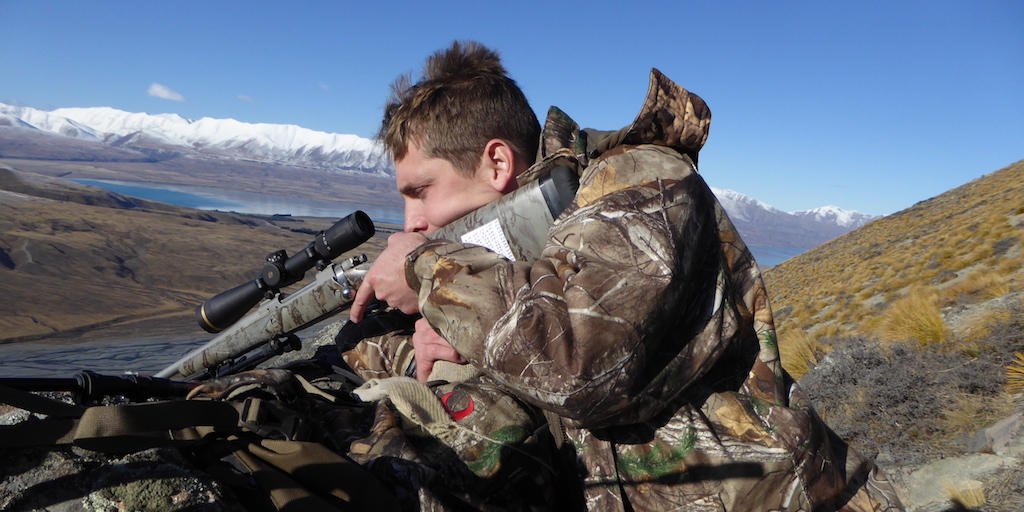
Do you want the cartridge best suited for target shooting out to 1,500 yards or so in a precision rifle? Go with the .338 Lapua. It’s specifically designed for this sort of work and stands head and shoulders above almost all other rifle cartridges for long range precision shooting. Like I mentioned earlier, Chris Kyle used a 338 Lapua to make his longest confirmed kill of 2,100 yards in Iraq.
Speaking of Chris Kyle though, it’s also worth noting that the 300 Win Mag was his favorite cartridge. Here’s what Chris had to say about the .300 Win Mag on page 116 of his book American Sniper:
“It shoots like a laser. Anything from a thousand yards and out, you’re just plain nailing it. And on closer targets, you don’t have to worry about too much correction for your come-ups.”
He was definitely using a little hyperbole there, but it’s absolutely true that the .300 Win Mag does indeed shoot quite a bit flatter than the 7.62x51mm cartridge that American military snipers have also used extensively over the years.
It’s no 338 Lapua Magnum, but the 300 Win Mag is no slouch either.
Do you want an ideal cartridge for especially large game like red stag, moose, eland, or a big bull elk? All three cartridges are capable of getting the job done on all of these species. Choosing the “best” one really depends on the hunter and the exact situation, but due to the aforementioned issues, the .338 Lapua isn’t a practical choice for most hunters (it will certainly work though).
I really like the 300 Win Mag on elk and moose and I don’t think you can go wrong with the .300 Win Mag for any of those species during a hunt in Africa, North America, Europe, New Zealand, or elsewhere.
There’s also a strong argument to be made for the 338 Win Mag here too.
Of these three, I’d personally lean towards the .338 Win Mag for those really big and tough animals, especially if you’re hunting in an area where it’s possible you might run into a brown or grizzly bear.
For instance, we use a Howa 1500 chambered in 338 Win Mag as a client rifle for hunting plains game in South Africa. That rifle wears a suppressor, so recoil is surprisingly light, but it hits game like a hammer.
I’m not exaggerating when I say our clients have used that rifle to take literally hundreds of animals over the past decade. This includes everything from impala and blesbok up through the larger and tougher species of plains game like gemsbok, zebra, blue wildebeest, sable, kudu, and eland.
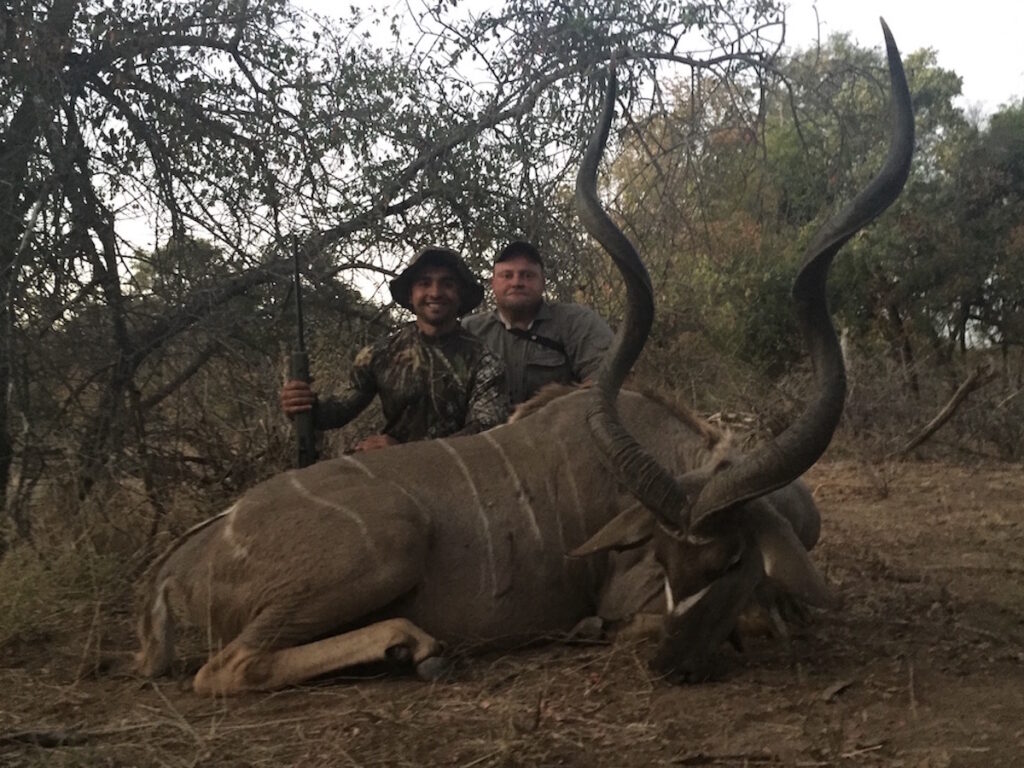
We started out using plain old 250 Remington Core Lokt ammunition (like with the kudu above), but we have since transitioned to using 210gr Barnes TTSX bullets and have never looked back (a 250 grain Nosler Partition would be a fantastic choice for these hunts too).
In fact, we used that exact Barnes load to take one of our biggest kudu ever a few years ago. That hunter was on safari near the end of the dry season and happened upon this ancient kudu bull, which had horns nearly 60″ long!
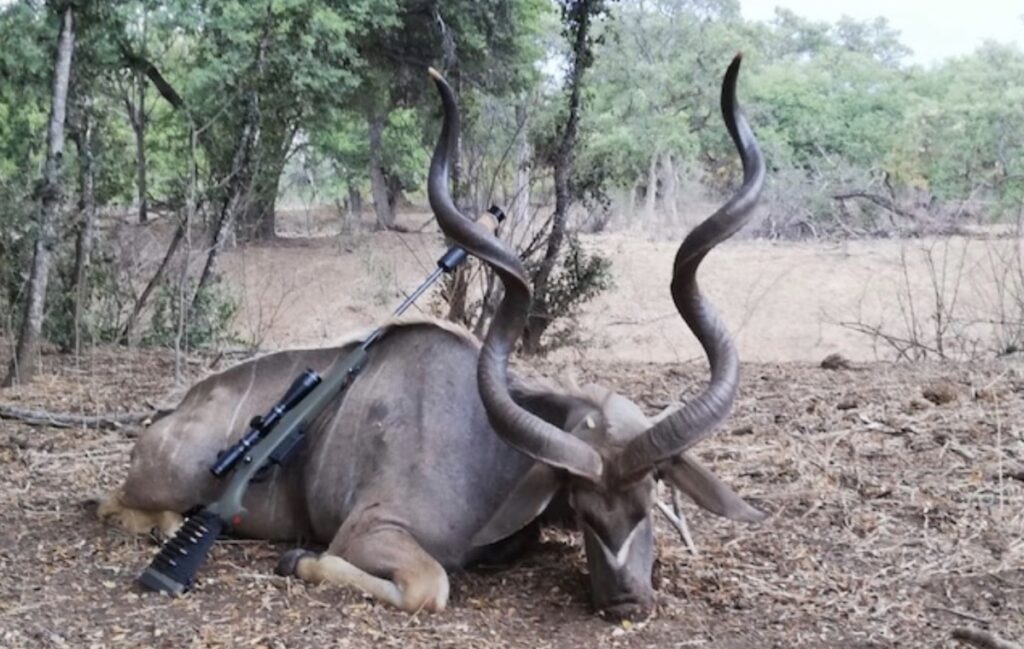
For reference, a 60″ kudu bull is on the level of a 400″ elk or a 200″ whitetail.
It’s very, very unusual that an animal requires more than one shot from our 338 Win Mag and this kudu was no exception.
Those results aren’t limited to Africa either. A friend of mine has a Blaser R8 chambered in 338 Win Mag he has used extensively in Europe. He used it with some Hornady 225gr GMX ammunition to take a couple of Ibex in Spain as well as several very nice looking red stag (like the one below he took in Germany).
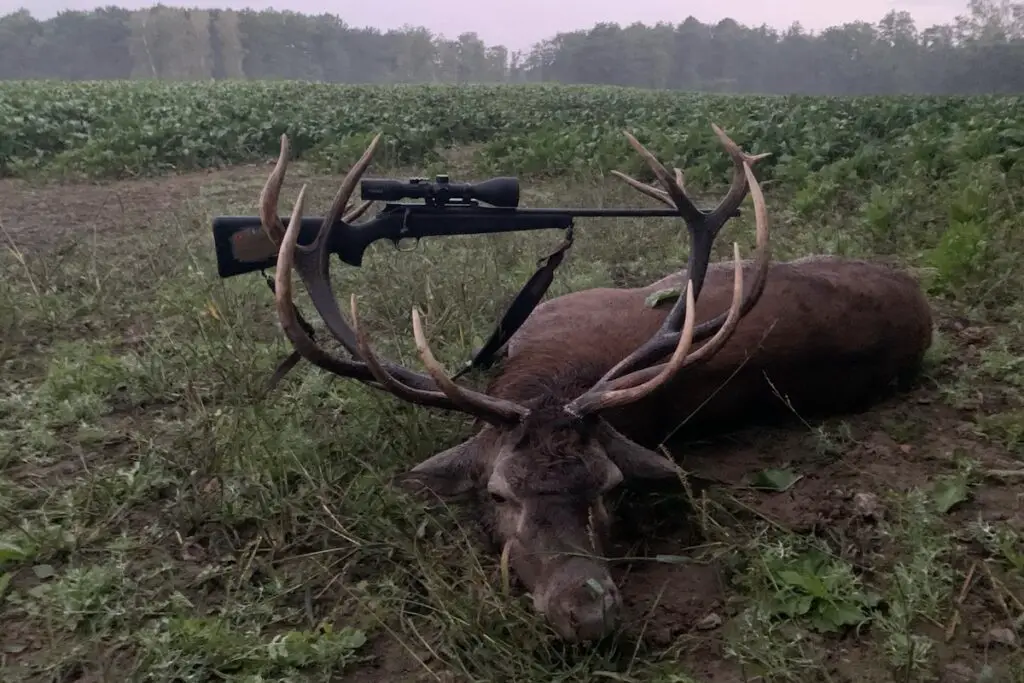
In each case, his guides were shocked at the power of the 338 Win Mag and of the stunning and immediate effect it had on game after the shot.
With all that in mind, it’s easy to see why the 338 Win Mag is such a highly regarded cartridge for hunting all manner of game, but especially the larger species.
Are you specifically hunting brown or grizzly bear? What if you hunt in Canada or Alaska and need a heavy hitting cartridge just in case you find yourself on the wrong end of a grizzly/brown bear attack? The .300 Win Mag will work in a pinch, but the .338 Win Mag is a clear winner here since it uses larger diameter and heavier bullets. After all, there’s a reason why it’s such a popular cartridge among African as well as Alaska and Canada hunting guides.
When you are faced with an angry brown bear coming straight at you (like the Alaskan hunting guide below did with a brown bear his client wounded on Kodiak Island), I’d much prefer a 338 Win Mag over the 300 Win Mag or even the 338 Lapua Magnum.
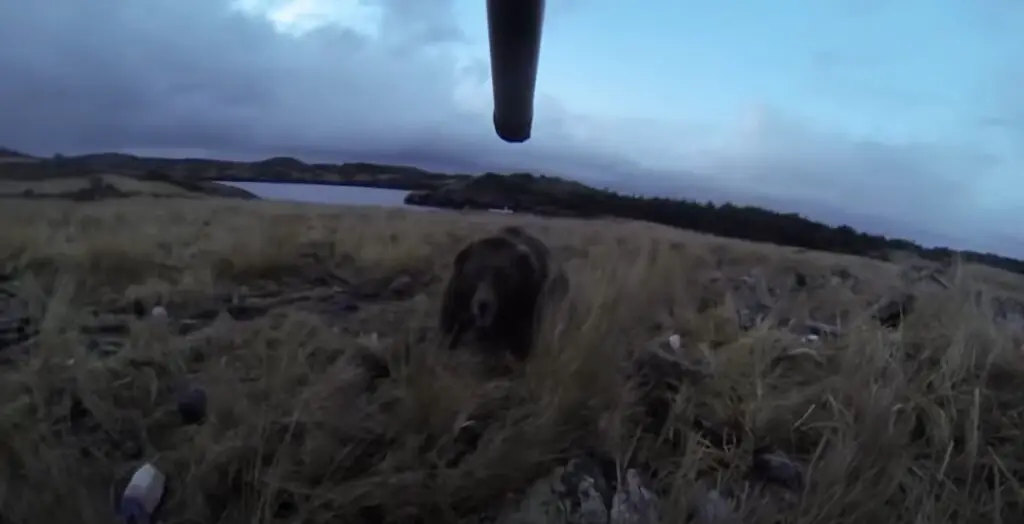
Fortunately, that guide kept his wits about him and stopped that bear at his feet!
As I’ve stated multiple times in this article, the .300 Winchester Magnum, the .338 Winchester Magnum, and the .338 Lapua are all excellent rifle cartridges overall. However, while they all perform extremely well in their intended roles, the differences between them (300 Win Mag vs 338 Lapua vs 338 Win Mag) are very big in certain areas. So, carefully analyze your potential needs and purchase the one you think will fit them best.
300 Win Mag vs 338 Win Mag vs 338 Lapua Frequently Asked Questions
Do snipers use 300 Win Mag?
Yes, the 300 Win Mag has seen extensive use with military and police snipers all over the world. In fact, legendary Navy SEAL Chris Kyle used the 300 Win Mag more than any other cartridge during his Iraq deployments chronicled in his autobiography American Sniper.
What is the difference between a 338 Lapua Magnum and a 300 Win Mag?
The 338 Lapua Magnum is a larger caliber cartridge with a gigantic case that can hold much more powder. The end result is the 338 Lapua shoots heavier and larger diameter .338″ bullets a little faster than the 300 Win Mag shoots .308″ bullets, but also has much recoil energy.
What is the difference between 338 Win Mag and 338 Lapua?
Both cartridges shoot the same .338″ diameter bullets, but the 338 Lapua has a much larger case and can shoot heavier and more aerodynamic bullets than the 338 Win Mag. For this reason, the 338 Lapua is a much more powerful cartridge with a flatter trajectory, but the 338 Win Mag has less recoil.
What is better than a 338 Lapua?
The 300 PRC is a more modern rifle cartridge that has a very similar trajectory to the 338 Lapua. Additionally, the 300 PRC has much less recoil, but is still plenty powerful itself and is well suited to many of the same applications the 338 Lapua excels in.
Enjoy this article comparing the .300 Winchester Magnum, .338 Winchester Magnum, and .338 Lapua cartridges? Please share it with your friends on Facebook and Twitter.
The Lyman 50th Edition (p260-262 294-295, 300-301) and Hornady 10th Edition (p574-585, 659-661, 668-671) reloading manuals were used as references for the history of the cartridges. The data used to compare the trajectory and wind drift of the 300 Win Mag vs 338 Lapua vs 338 Win Mag was obtained from Hornady and Winchester. Case capacities were obtained from Nosler (here, here, and here). Maximum pressure obtained from SAAMI (p30-32). I used the Hornady Ballistic calculator and ShootersCalculator.com to compare trajectory, wind drift, and recoil for the cartridges.
Make sure you subscribe to The Big Game Hunting Podcast and follow The Big Game Hunting Blog on Facebook, Instagram, Twitter, and YouTube.
NEXT: 270 vs 30-06 DEBATE SOLVED ONCE AND FOR ALL
NEXT: 6.5 PRC: ULTIMATE GUIDE TO WHAT YOU NEED TO KNOW
John McAdams is a proficient blogger, experienced shooter, and long time hunter who has pursued big game in 8 different countries on 3 separate continents. John graduated from the United States Military Academy at West Point and is a veteran of combat tours with the US Army in Iraq & Afghanistan. In addition to founding and writing for The Big Game Hunting Blog, John has written for outdoor publications like Bear Hunting Magazine, The Texas State Rifle Association newsletter, Texas Wildlife Magazine, & Wide Open Spaces. Learn more about John here, read some of John’s most popular articles, and be sure to subscribe to his show: the Big Game Hunting Podcast.


Honestly the answer to which of the 3 is actually to introduce a 4th. The 30 Nosler. No belt to deal with in FL resizing. A couple hundred fps faster with the heavy 30 Cal bullets which given their bc puts it right in the range of energy while flatter shooting than even the LM until you get to ranges people do not hunt game at except very rarely 1200+.
30 Nosler
26″ barrel throated to allow proper bullet seating loaction
250gr/2825fps .878 (G1) .442 (G7)
230gr/3000fps .823 (G1) .414 (G7)
215gr/3150fps .691 (G1) .354 (G7)
200gr/3250fps .640 (G1) .328 (G7)
190gr/3325fps .541 (G1) Cu Mono
176gr/3450fps .564 (G1) .284 (G7)
Honestly a better comparison than 338LM would have been the 338NM it’s a much more fitting hunting cartridge and has started replacing the Lapua in a number of military platforms as it can have the bullet seated at a ideal position in the case and still easily fit in standard LA magazines and in a mag load setup matches the larger Lapua case with the bullet buried in the case to allow it to fit in the mag. It’s also inherently more accurate and efficient. It’s basically a shortened blown out lapua case akin to an up sized short mag(wsm/rsaum) About equal to a Nosler Mag but in a shorter fat case. About the ratio of the short mags.
With that said I have to say you write very well balanced articles making real efforts to not let personal bias in. Rare and Great!
In general you will find the largest % of 338WM per shooters in Alaska. Basically where unintended brown bear moose run ins are high. (I will say though as big as moose are unless you get a bull stirred up they basically just stand or lay down and die when shot. Nothing like elk or Mullie.)
300WM for where distances stretch out.
338NM where distances are long and game is larger.
Personally I like 35-40 degree shoulders so I tend to run customized versions of most cartridges. I like things to be as efiecent as I can make them but then I handload for everything I shoot even my ARs and handgun shotguns. I also set throats to offer the best match seating bullets ideally for those I plan to use.
Many do not handload or customize chambers so that understandably changes things…..
Great article. I have been looking for just such an article comparing the 3 cartridges. Thank you.
Glad you enjoyed it Sean!
John
Absolutely fascinating article I really appreciate it the knowledge you shared. I am considering a Blaser R8 professional success, In 338 Lappula
I’m planning on hunting big game from A distance of 400 yards plus and I also plan on utilizing a muzzle brake. Do you think this rifle will be able to absorb enough recoil to not make it miserable to shoot.
Glad you enjoyed the article Darryl.
Looks like the Blaser R8 Professional Success weighs a little over 8 pounds. Let’s say that it weighs 10 pounds after you add a scope, sling, etc. That works out to about 48 foot pounds of free recoil energy using the exact load I used in the recoil comparison in the article. Let’s say that a really good muzzle brake can reduce recoil by 20%. That works out to about 38 foot pounds of free recoil energy for that load with the muzzle brake.
That’s not nothing, but you’re starting to get down into a more manageable amount of recoil with at this point.
Will it be miserable to shoot? It all depends on how well you tolerate recoil. I can tell you right now that many people will still have a hard time dealing with that much recoil, but many other people will be able to handle it without too much trouble.
Hope this helps!
John
I very much enjoyed reading your article. I am a 70 year old FFL, shooter,and gunsmith that just this year started hunting. I have many rifles and I love to compare. I’m going on a Elk hunt, my first, so I purchased a Benelli Lupo in 300 WM. As I’m not renewing my FFL in December I bought a .338 Lapua to pursue long range shooting. Your article answered all my questions in a very fine orderly manner.
Well done! I’m not too recoil sensitive as I shoot my 500 NE a few times a year, I do like to keep things in perspective. I put a large muzzle break on the Lupo and it recoils like a 5.56. Amazing!! Keep up the good work. Your articles are fact filled and easy to follow. Thank you for the information.
Kind regards, Bruce
Thanks Bruce! I’m glad you enjoyed it!
John
Nice article. I live in Pacific northwest and have used my model 70 338wm for years for elk with great results (nothings ever run off after being hit) i do recommend this caliber. The kick wasn’t too bad when i was younger not in love with it now..lol .
My son will probably inherit the rifle soon as i will be looking into stepping down alittle after reading this along with other research to a 300wm.